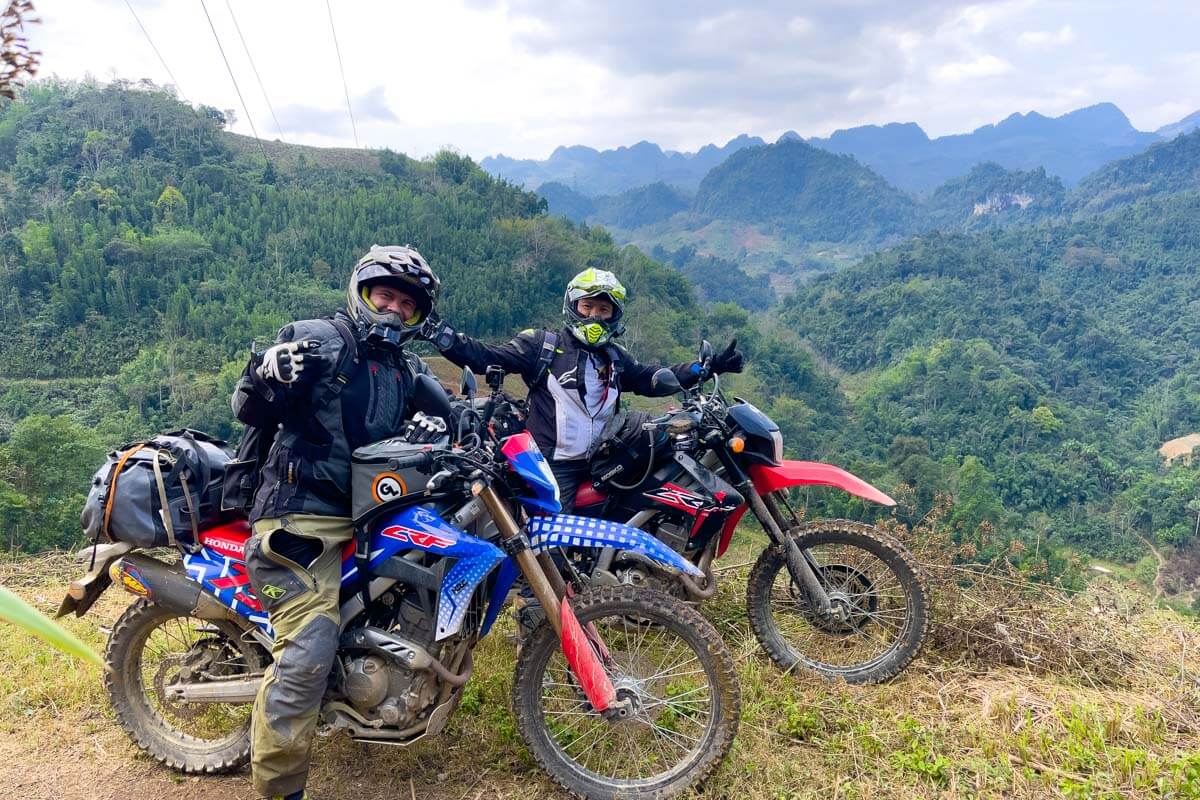
Looking to get into the go-anywhere, ride-anything side of motorcycling? Here are the 7 best dual sport motorcycles for beginners worth considering this coming year.
In essence, a dual sport is just a street-legal dirtbike with a headlight. If that sounds like a good time to you—it should, and we'd argue that few machines deliver on that all-important fun factor quite like a dual sport.
With that being said, these bikes come in many different flavors, and not all dual sport motorcycles are ideal for new riders.
You'd be surprised how many folks on our international dual sport tours have never ridden off-road, so we've experienced firsthand what works and what doesn't for new dual sport riders.
If you're looking to buy your first dual sport, here are a few key points we've learned over the years you'll want to consider.
What Should I Look For In A Beginner Dual Sport?
In the broadest terms possible, you want your first dual sport experience to be both as low-stress and high-fun as possible.
As you might expect, starting out on a fire-breathing race enduro won't exactly inspire confidence, but here are a few things that will.
Comfortable Ergonomics

"Being able to reach the ground with both feet goes a long way."
As we noted above, dual sports are only a few steps removed from their off-road-only counterparts, and as such they tend to be much taller than your average street bike.
That's all good and well for taller folks, but a shorter reach to the ground goes a long way toward building confidence in newer riders.
There's no magic number here, but we do recommend shorter riders consider lower seats (below 33 inches ideally), and it isn't a bad idea for taller folks either, truth be told.
Go sit on a few bikes you're interested in at your local dealership to get a feel for what suits you.
Less Power, Smoother Delivery

"You'd be surprised how much you can do with 30 horsepower or less off-road."
Plain and simple, you don't need a ton of horsepower to enjoy the ride, especially when you're riding off-road on a dual sport motorcycle. To that end, we recommend newer riders start with something around 30 horsepower or lower.
We'll also point out that how that power is delivered is equally important.
Expert-level dual sports can do some pretty explosive things when you grab a handful of throttle, so a good beginner bike should be as smooth and predictable as possible to avoid surprises.
Keep the Weight to A Minimum

"Lighter bikes are easier to handle, especially for dual sport beginners."
Lighter bikes are easier to control, easier to maneuver, and easier to pick up when you happen to drop them on the ground. That last part is particularly important because crashing happens much more often in the dirt.
We recommend keeping your first dual sport motorcycle around 300 pounds or less, and that includes fluids like oil, gas, coolant, etc.
A lot of off-road riding happens at much slower speeds than pavement, and lighter bikes breed confidence when the going inevitably gets slow and tricky.
Street v. Dirt Bias

"Bikes like this CRF300L split the difference between street and dirt well and still shred when called upon."
"Dual sport" is sort of a catch-all term for any lightweight motorcycle that works in the dirt but can also be ridden (legally) on the street.
As such, some of them are built with a more hardcore focus on dirt performance at the cost of day-to-day practicality.
Generally speaking, we recommend steering clear of higher-strung, higher-maintenance machines for a first dual sport.
Good suspension is more important in the dirt than sheer horsepower anyways, so if you're leaning more toward a dirt bias yourself, focus your investment there.
Our Favorite Beginner Dual Sport Motorcycles
Keeping the above factors in mind, there are currently a handful of dual sports out there that we wouldn't hesitate to recommend to any new rider.
These models span a decent range in size and price, but they're all reliable, beginner-friendly, and capable to varying degrees in the dirt.
1. Honda CRF300L/300LS

MSRP: $5,449
Honda's CRF300L is arguably the most popular dual sport motorcycle currently in production for beginners and veterans alike. It combines rock-solid reliability with real off-road performance and solid street manners, and does it all at a price that's hard to ignore.
We've logged our fair share of miles on the 300L and found it's particularly well-suited for beginners due to its smooth-revving engine, featherlight clutch, and lower-than-average seat height.
 "We have extensive experience on these bikes on our Vietnam tours"
"We have extensive experience on these bikes on our Vietnam tours"
Don't get us wrong: the 300L is still a tall bike at 34.7 inches, but it's low for the segment (especially considering its 10+ inches of suspension travel) so it works well for riders under 6 foot.
While the 300L's suspension is a little soft for higher-speed off-roading, it's still plenty capable and much more comfortable for beginners than stiffer, hard-charging alternatives.
There's plenty of support for the 300L in the aftermarket, however, which means this Honda can be easily upgraded if needed as your skills progress.
PROS |
CONS |
|
|
2. Yamaha XT250

MSRP: $5,299
Yamaha's XT250 has been around for a while because its simple yet effective formula works great as a beginner dual sport. It's a basic machine by any measure, but it's also an impressively capable one, and has made a great addition to our rental fleet.
The secret of the XT lies in its extremely low center of gravity. Despite its excellent 11+ inches of ground clearance and respectable 8.9 inches of suspension travel, the little 250's low seat and compact design make it very stable and easy to control.
It's also an extremely easy bike to flat foot for shorter riders, as well as a particularly light one at under 300 pounds gassed-up and ready to go.
The air-cooled engine is no speed demon and long stretches on the freeway aren't particularly pleasant, but it's geared well for all-terrain use and is backed by Yamaha's legendary reliability.
PROS |
CONS |
|
|
3. Suzuki DRZ400S

MSRP: $7,199
Suzuki's DRZ400S is nothing short of legendary. A lighter and more off-road-focused sibling of the DR650 (also legendary), this water-cooled single-cylinder has reliably carried beginners and veterans alike to all corners of the globe.
The great thing about the DRZ is that despite its roughly two-decades-old design, everything about it simply works for dual sport use.
 "Perfect bike to bring to our Offroad Training Centers in Bend Oregon and Parumph Nevada."
"Perfect bike to bring to our Offroad Training Centers in Bend Oregon and Parumph Nevada."
The suspension is firm enough for serious off-roading and corner carving, the engine makes good usable power throughout the rev range, and every component of the bike is both dead-reliable and incredibly easy to work on.
As far as downsides go, the main drawback here is price, as the DRZ still retails for considerably more than the modern crop of 300cc machines despite its similar capability.
We'd still give the nod to the DRZ due to its proven track record and extensive aftermarket support though, so consider buying a well-kept used one if you want to experience it for yourself.
PROS |
CONS |
|
|
4. Honda XR150L

MSRP: $3,099
If ever there were a bike that exemplified beginner-friendly, it's the Honda XR150L. It's low to the ground, lightweight, and insanely easy to ride, so much so that it became our weapon of choice for teaching new riders how to work a clutch this year.
The other incredibly appealing aspect of the XR is its asking price. With an MSRP of just $3,099, Big Red is officially charging no-name Chinese knock-off prices for a legitimate Honda dual sport and all the quality, reliability, and dealer support that comes with it.
 "On our scouting trip to Vietnam a majority of our riders rallied the XL150L and it got the job done."
"On our scouting trip to Vietnam a majority of our riders rallied the XL150L and it got the job done."
With that being said, it's important to note that as the smallest displacement motorcycle on this list, the XR150L is the only motorcycle that really has no business going over 60mph.
It's also limited in its off-road capability due to basic suspension and limited ground clearance, but for basic gravel and dirt roads, it's good fun.
PROS |
CONS |
|
|
5. Kawasaki KLX 230S

MSRP: $4,999
The KLX230S is Kawasaki's entry-level dual sport, and it's about as beginner-friendly as they come. It's got an always-fun-but-never-intimidating engine, good off-road manners, and a much more affordable asking price than its good looks might imply.
Because this is the "S" version of the KLX230, you're also getting a lower seat (33.2 inches), which Kawasaki achieves by chopping about two inches off the suspension travel.
Don't let that scare you off though: Kawasaki also revised the spring/damping settings to be firmer on the "S" model, so it still works great on and off pavement.
With its fuel-injected engine, low center of gravity, and ABS brakes, the KLX is easy to ride, easy to maintain, and legitimately confidence-inspiring in the hands of newer riders.
It's a little down on power for highway speeds and a little cramped for taller riders (the same goes for the standard KLX230, FYI), but all things considered, it's an excellent option all around for all-terrain exploration and day-to-day use.
PROS |
CONS |
|
|
6. Kawasaki KLX 300

MSRP: $5,449
Digging the KLX230S above but want something a little more capable? Kawasaki's recently redesigned KLX300 looks as sharp as it rides and is one of the most off-road capable dual sports in the beginner segment.
The 300 is bigger and better in every way, with significantly improved suspension, power, and handling, but it's in no way intimidating for new riders either.
 We're still talking about a bike that makes less than 30 horsepower and weighs in at a fairly light 302 pounds with a full tank of fuel.
We're still talking about a bike that makes less than 30 horsepower and weighs in at a fairly light 302 pounds with a full tank of fuel.
We also love the KLX300 because its adjustable suspension is good enough to tackle serious enduro terrain once new riders get comfortable enough to start pushing their limits.
It's still a far cry from premium 300cc machines from folks like KTM, but it'll do just about anything you ask it to including interstate travel if you don't mind a little vibration at the bars.
PROS |
CONS |
|
|
7. Yamaha TW200

MSRP: $4,999
Some motorcycles are legendary for their performance, others for their character. The Yamaha TW200, with its fat tires, air-cooled engine, and '80s style is firmly in the second camp.
Essentially unchanged since the first one rolled off the assembly line back in 1987, Yamaha's TW200 is the definition of a farm bike: it sits low, it moves slow, and it simply chugs its way through anything and everything including sand, mud, and steep inclines.
All of those things, as well as its exceptionally low 31.1-inch seat height, make the TW200 a shoo-in as a beginner dual sport.
We'd argue that its dated components (air-cooled, carbureted, drum brake, etc.) make it a little overpriced, considering modern fuel-injected 300s go for a few hundred dollars more, but the little Tee-Dub is a whole different animal that makes its own fun just the same.
PROS |
CONS |
|
|
→Read More:
Best Lightweight Adventure Motorcycles
6 Best Dual Sport Helmets
Best Dual Tires for Serious Off-Road Riding



